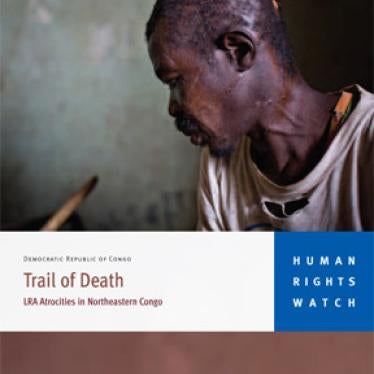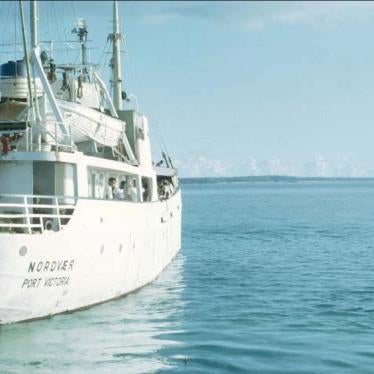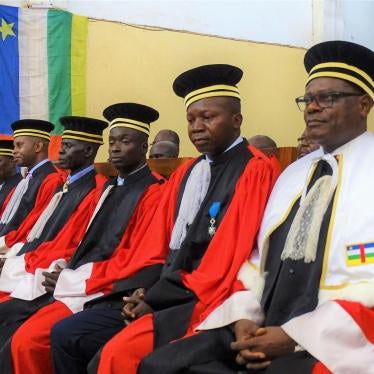(Kampala) - The rebel Lord's Resistance Army (LRA) killed at least 321 civilians and abducted 250 others, including at least 80 children, during a previously unreported four-day rampage in the Makombo area of northeastern Democratic Republic of Congo in December 2009, Human Rights Watch said in a report released today.
"The Makombo massacre is one of the worst ever committed by the LRA in its bloody 23-year history, yet it has gone unreported for months," said Anneke Van Woudenberg, senior Africa researcher at Human Rights Watch. "The four-day rampage demonstrates that the LRA remains a serious threat to civilians and is not a spent force, as the Ugandan and Congolese governments claim."
The 67-page report, "Trail of Death: LRA Atrocities in Northeastern Congo," is the first detailed documentation of the Makombo massacre and other atrocities by the LRA in Congo in 2009 and early 2010. The report, based on a Human Rights Watch fact-finding mission to the massacre area in February, documents the brutal killings during the well-planned LRA attack from December 14 to 17 in the remote Makombo area of Haute Uele district.
LRA forces attacked at least 10 villages, capturing, killing, and abducting hundreds of civilians, including women and children. The vast majority of those killed were adult men, whom LRA combatants first tied up and then hacked to death with machetes or crushed their skulls with axes and heavy wooden sticks. The dead include at least 13 women and 23 children, the youngest a 3-year-old girl who was burned to death. LRA combatants tied some of the victims to trees before crushing their skulls with axes.
The LRA also killed those they abducted who walked too slowly or tried to escape. Family members and local authorities later found bodies all along the LRA's 105-kilometer journey through the Makombo area and the small town of Tapili. Witnesses interviewed by Human Rights Watch said that for days and weeks after the attack, this vast area was filled with the "stench of death."
Children and adults who managed to escape provided similar accounts of the group's extreme brutality. Many of the children captured by the LRA were forced to kill other children who had disobeyed the LRA's rules. In numerous cases documented by Human Rights Watch, children were ordered to surround the victim in a circle and take turns beating the child on the head with a large wooden stick until the child died.
The United Nations Peacekeeping Mission in Congo (MONUC) has some 1,000 peacekeeping troops in the LRA-affected areas of northeastern Congo - far too few to protect the population adequately, given the area's size. Yet instead of sending more troops, the peacekeeping force, under pressure from the Congolese government to withdraw from the country by July 2011, is considering removing some troops from the northeast by June in the first phase of its drawdown.
"The people of northeastern Congo are in desperate need of more protection, not less," said Van Woudenberg. "The UN Security Council should stop any drawdown of MONUC peacekeeping troops from areas where the LRA threatens to kill and abduct civilians."
In mid-April, the Security Council is due to visit Congo to discuss the peacekeeping force's plans for withdrawal and the protection of civilians.
The Makombo massacre is part of a longstanding history of atrocities and abuse by the LRA in Uganda, southern Sudan, the Central African Republic (CAR), and Congo. Pushed out of northern Uganda in 2005, the LRA now operates in the remote border area between southern Sudan, Congo, and CAR. In July 2005, the International Criminal Court issued arrest warrants for the senior leaders of the LRA for crimes they committed in northern Uganda, but those indicted remain at large.
The Human Rights Watch research indicated that the Makombo massacre was perpetrated by two LRA commanders - Lt. Col. Binansio Okumu (also known as Binany) and a commander known as Obol. They report to Gen. Dominic Ongwen, a senior LRA leader who is believed to command the LRA's forces in Congo and who is among those sought by the International Criminal Court. Human Rights Watch urged investigations of these commanders' alleged participation in war crimes and crimes against humanity.
In December 2008, the governments of the region, led by the Ugandan armed forces, with intelligence and logistical support from the United States, began a military campaign known as Operation Lightning Thunder against the LRA in northeastern Congo. A surprise aerial strike on the main LRA camp failed to neutralize the LRA leadership, which escaped. In retaliation, the LRA attacked villages and towns in northern Congo and southern Sudan, killing more than 865 civilians during the Christmas 2008 holiday season and in the weeks thereafter.
On March 15, 2009, Operation Lightning Thunder officially ended, following pressure from the Congolese government, which found it politically difficult to support a continued Ugandan army presence on Congolese territory. But a covert joint military campaign continued, with the quiet approval of the Congolese president, Joseph Kabila. Both governments publicly maintain that the LRA is no longer a serious threat in Congo and that the bulk of the rebel group has either moved to Central African Republic or has been killed or dispersed.
These public declarations might have contributed to burying information about ongoing LRA attacks, leaving many victims feeling abandoned. An 80-year-old traditional chief, whose son was killed during the Makombo massacre, told Human Rights Watch: "We have been forgotten. It's as if we don't exist. The government says the LRA are no longer a problem, but I know that's not true. I beg of you, please talk to others about what has happened to us."
While the Makombo massacre is the most deadly documented attack by the LRA since the Christmas massacres of 2008, dozens of attacks against civilians have also been carried out in other areas in recent months - near the towns of Bangadi and Ngilima in Haut Uele district, in Ango territory in Bas Uele district, as well as in the Central African Republic.
In the December 2009 attacks near Bangadi and Ngilima, LRA combatants horribly mutilated six civilians, cutting off each victim's lips and an ear with a razor. The LRA sent the victims back to their villages with a chilling warning to others that anyone who heard or spoke about the LRA would be similarly punished.
On March 11, 2010, the US Senate unanimously passed the Lord's Resistance Army Disarmament and Northern Uganda Recovery Act. If it becomes law, it will require President Barack Obama's administration to develop a regional strategy to protect civilians in central Africa from attacks by the LRA, to work to apprehend the LRA's leadership, and to support economic recovery for northern Uganda. The bill is currently before the House Committee on Foreign Affairs.
"The people of northeastern Congo and other LRA-affected areas have suffered for far too long," said Van Woudenberg. "The US and other concerned governments should work with the UN and regional parties to develop and carry out a comprehensive strategy to protect civilians and apprehend abusive LRA leaders."







